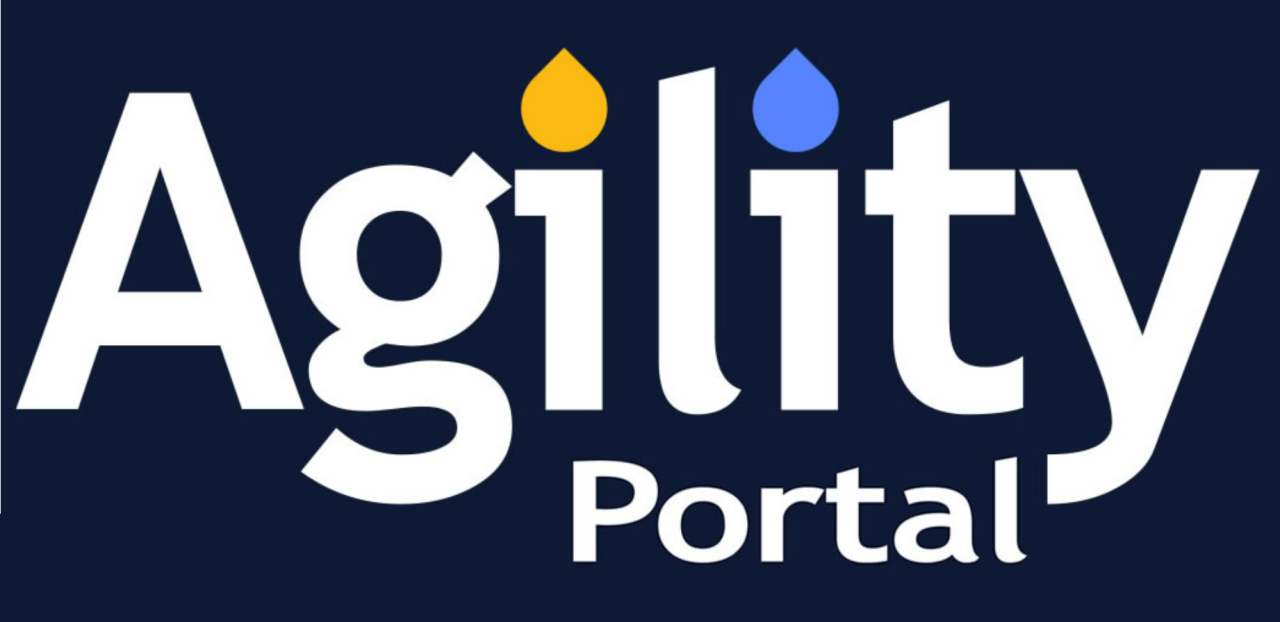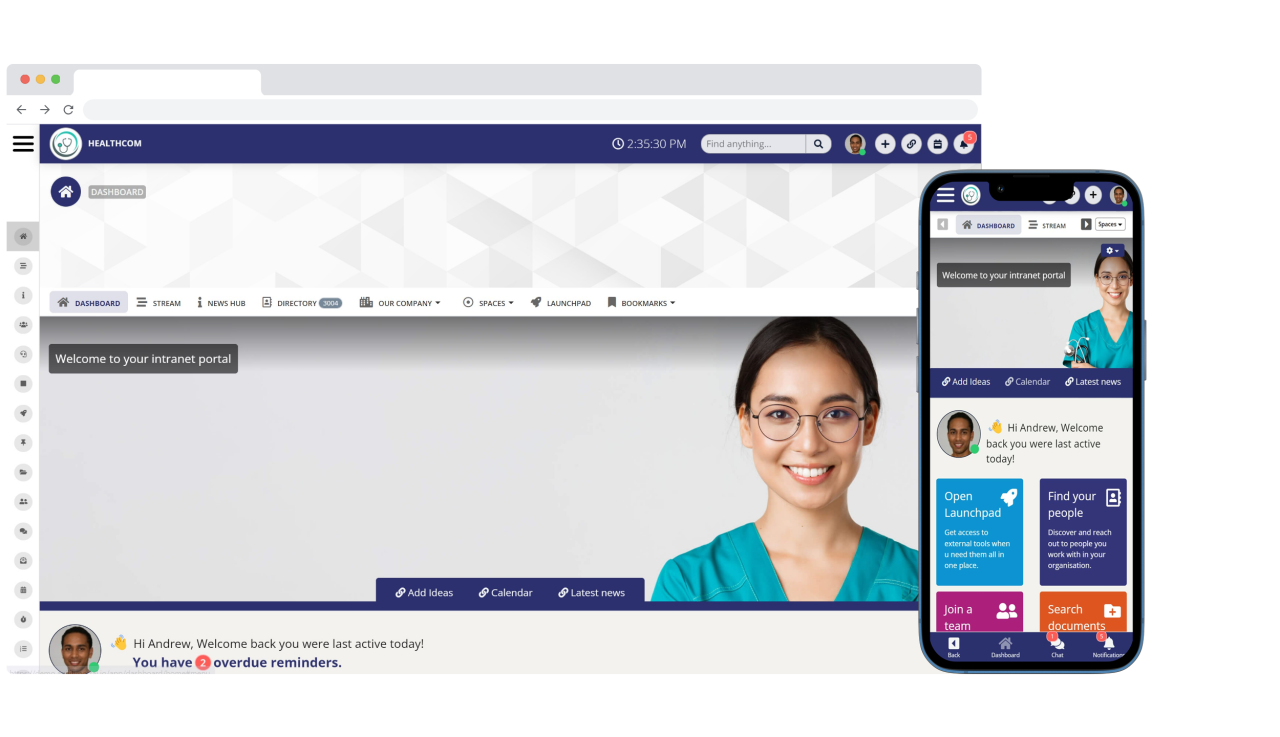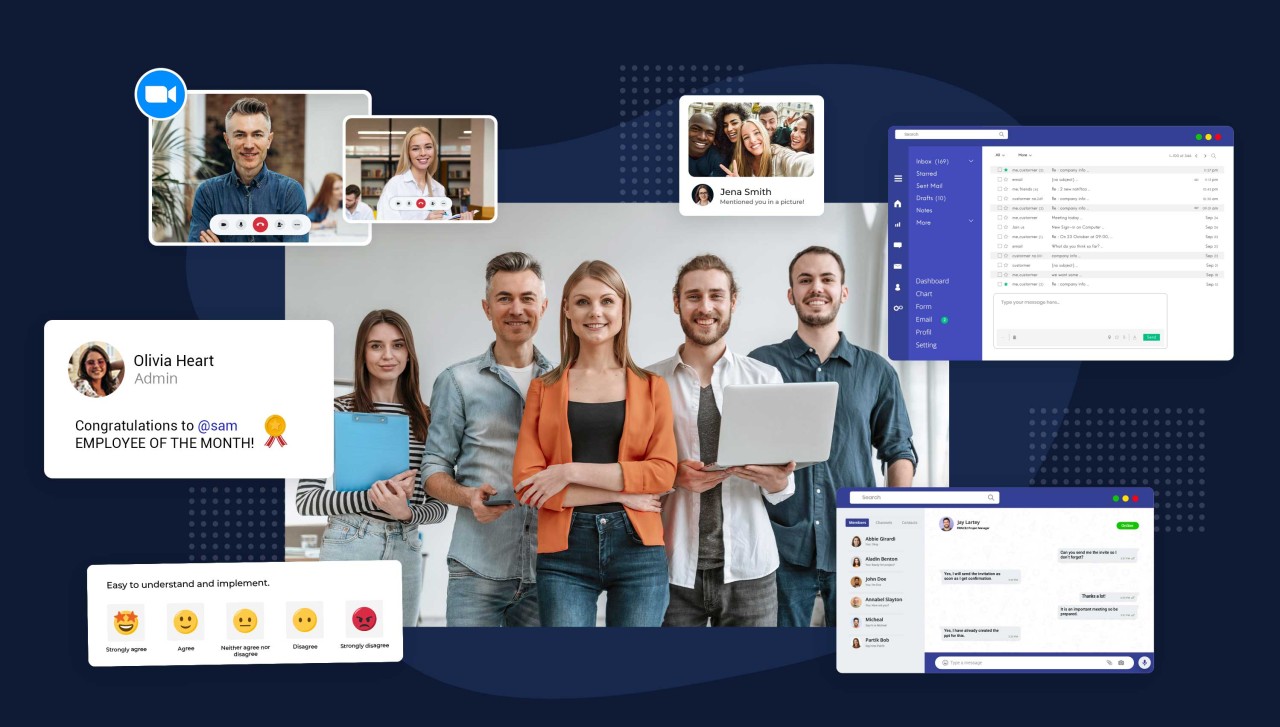Insight Blog
Agility’s perspectives on transforming the employee's experience throughout remote transformation using connected enterprise tools.
14 minutes reading time
(2762 words)
What Is An Employee App? Why You Need One in 2024
Todays question is What Is An Employee App? Whether working from home, different offices, or on the go, the employee app acts as a unifying force, read more.
Todays question is What Is An Employee App? The way we conduct work has undergone significant changes since 2019, and there's no turning back. Despite the advantages of our new work habits, it's not a perfect scenario.
While many employees express satisfaction with remote work, burnout levels remain high, with nearly 50% experiencing symptoms, irrespective of their work location.
Furthermore, about 36% of those working from home, as reported:
- 87% of businesses rely on their employees to use their personal mobile devices to access company apps (Syntonic)
- 75% of people say their smartphones make them more productive (Google)
- 97% of users have productivity apps on their smartphones (GoodFirms)
- 82% of IT executives say smartphones are highly important to employee productivity (Samsung/Oxford Economics)
- 88% of highly engaged employees have control over their workplace. BYOD (Bring Your Own Device) provides some of that control (Gallup)
- 53% of executives said apps improve business processes and increase productivity (Perillon)
Remote and hybrid work are becoming permanent, but they pose challenges to employee communication and relationships.
One potential solution is the implementation of an employee app. Uncertain about what it is or why you might need one? Find answers below.
What Is An Employee App
What Is An Employee App or Staff Communication App? An employee app encompasses various tools or platforms strategically crafted to streamline work processes.
The market boasts a plethora of options, ranging from straightforward real-time internal communication tools to sophisticated applications facilitating seamless project collaboration. In the subsequent discussion, we will delve into some key categories of employee apps, providing illustrative examples for better comprehension.
Implementing an employee app empowers your team with on-demand access to personalized, pertinent, and valuable information essential for executing their roles efficiently. Beyond mere information dissemination, these apps foster the creation of a digital arena where staff can engage in open communication, collaborate with efficiency, and cultivate workplace relationships, transcending geographical constraints.Moreover, these apps serve as a bridge, connecting team members irrespective of their physical locations. Whether working from home, different offices, or on the go, the employee app acts as a unifying force, ensuring seamless connectivity and a shared space for meaningful interactions. It becomes a hub for exchanging ideas, coordinating tasks, and building a cohesive work culture that transcends traditional office boundaries.
In the upcoming sections, we'll explore prominent types of employee apps, shedding light on their functionalities and the tangible benefits they bring to modern workplaces.
This detailed exploration aims to provide a comprehensive understanding of the diverse landscape of employee apps, empowering businesses to make informed decisions tailored to their specific needs and objectives.
Employee app spans across multiple functions, including:
Employee apps, whether mobile or web-based, are crafted to enhance the employee experience and facilitate various aspects of work.
Communication and Collaboration:
- Establishing a central hub for individual and group communication.
- Facilitating file sharing, project collaboration, and task management.
- Information Access:
- Providing easy access to critical company information like policies, procedures, employee directories, and HR benefits.
- Performance Management:
- Tracking employee performance, setting goals, and delivering feedback.
- Training and Development:
- Offering access to training and development resources for continuous learning.
- Employee Engagement:
- Enhancing engagement through connection opportunities, participation in company events, and reward programs.
Examples of specific functionalities within employee apps encompass:
- Viewing payroll and benefits information.
- Requesting time off and vacation days.
- Submitting expense reports.
- Accessing and approving company documents.
- Registering for training courses.
- Navigating company resources like directories, handbooks, and policies.
- Facilitating communication with colleagues and managers.
- Collaborating on projects and tasks.
- Providing feedback and suggestions.
- Participating in company polls and surveys.
- Earning rewards and recognition.
Regardless of the business size, employee apps serve as invaluable tools. They contribute to improved communication, heightened collaboration, increased employee engagement, and enhanced overall productivity.
These applications align with the evolving dynamics of the modern workplace, catering to diverse needs while fostering a more connected and efficient work environment.
Benefits of an employee app
Implementing an employee app in a workplace comes with a range of advantages, contributing to enhanced efficiency, communication, and overall employee satisfaction. Some key benefits of an employee app:
- Improved Communication:
- Real-Time Updates: Enables instant communication, ensuring employees stay informed about company news, updates, and announcements in real time.
- Centralized Hub: Provides a centralized platform for communication, reducing reliance on scattered channels.
- Enhanced Collaboration:
- Project Management: Facilitates collaborative project management, allowing teams to work together seamlessly regardless of physical locations.
- File Sharing: Streamlines file sharing, fostering efficient collaboration on documents, presentations, and other work materials.
- Access to Information:
- Information Centralization: Gathers essential company information in one accessible location, including policies, procedures, employee directories, and HR benefits.
- Self-Service: Allows employees to access their personal data, such as payroll and benefits information, promoting self-service efficiency.
- Increased Productivity:
- Task Management: Assists in task and project management, helping employees organize and prioritize their work.
- Time Savings: Reduces time spent on administrative tasks, allowing employees to focus on core responsibilities.
- Employee Engagement:
- Connection Opportunities: Facilitates employee engagement through features like communication tools, participation in events, and recognition programs.
- Feedback Mechanisms: Provides avenues for feedback, fostering a culture of continuous improvement.
- Performance Management:
- Goal Setting: Supports goal-setting processes and allows for tracking employee performance over time.
- Feedback Loops: Encourages regular feedback, contributing to professional development.
- Training and Development:
- Learning Resources: Offers access to training and development resources, promoting continuous learning and skill enhancement.
- Flexibility and Remote Work Support:
- Remote Accessibility: Ensures employees can stay connected and engaged, even when working remotely.
- Flexibility: Adapts to the evolving needs of flexible work arrangements.
- Data-Driven Insights:
- Analytics: Provides valuable insights through analytics, helping businesses understand employee engagement, app usage patterns, and more.
- Employee Satisfaction:
- User-Friendly Interface: Enhances overall employee experience with a user-friendly interface and intuitive features.
- Well-Being: Contributes to a positive work environment, supporting employee well-being and job satisfaction.
Implementing an employee app aligns with the modern workplace's evolving dynamics, fostering a connected, informed, and efficient workforce.
Follow us and access great exclusive content everyday: Follow us on Google News
Types Of Employee Apps
There is a diverse range of workplace apps, categorized based on features, areas of focus, and the size of organizations they cater to. Below, we outline the most prevalent types.
1.Employee Communications Apps
Communication apps, such as AgilityPortal, Zoom, or Microsoft Teams, serve the fundamental goal of facilitating the exchange of internal messages between a company and its employees, guiding them on how to utilize that information.
Additionally, these apps enable workers to engage in real-time conversations, fostering connections through features like screen sharing and video calls. This proves particularly beneficial for remote workers, creating a sense of belonging to the team even when they are physically distant from the office.
You may also like: Best Apps for Employees: UPDATED 2022 – A Complete Guide
2.Informational Apps
Facilitating efficient communication, these apps empower companies to transmit emergency alerts promptly and disseminate crucial organizational information to their workforce. Whether it's urgent updates, critical memos, timely reminders, or general announcements, these platforms serve as invaluable tools for ensuring that important messages reach employees swiftly, contributing to a well-informed and responsive workplace.
Moreover, the versatility of these applications extends beyond emergency communication.
They provide a centralized space for fostering consistent and transparent dialogue between the company and its employees, creating an environment where updates on projects, policy changes, and noteworthy achievements can be seamlessly shared.
In essence, these communication apps not only address urgent communication needs but also contribute to the overall cohesion and informed engagement of the entire workforce.
3.Workforce Apps
Workforce apps play a multifaceted role, aiding in diverse tasks such as onboarding new personnel, providing training modules, enhancing overall employee engagement, and efficiently managing a spectrum of talents within an organization.
Notably, the onboarding process is streamlined through these apps, ensuring a consistent experience for both in-office and remote teams. This uniform onboarding approach fosters cohesion and inclusivity, irrespective of an employee's physical location, setting the foundation for a unified company culture.
In addition to onboarding, certain platforms designed for employee screening and recruitment seamlessly integrate into the realm of HR apps. These tools not only streamline the hiring process but also contribute to the broader human resources landscape by facilitating efficient talent acquisition.
By encompassing tasks beyond onboarding, such as skill development, performance management, and talent retention strategies, these workforce apps emerge as pivotal components in shaping a robust and adaptable organizational ecosystem.
Free ebook: How To Get Your Intranet Off The Ground
4.Recognition Apps
This versatile app serves a dual purpose within the organizational framework. On the managerial front, company leadership utilizes it to recognize and commend employees for exemplary performance.
Simultaneously, it empowers individual workers to express congratulations, share cheers, and offer encouragement to their colleagues. Particularly beneficial for remote workers, this application becomes a vital conduit for acknowledging job well-done moments, filling the void left by the traditional in-person commendations that remote employees might miss out on.
Furthermore, certain apps are ingeniously designed as hybrids, seamlessly integrating the functionalities of both acknowledgment and information dissemination. Take, for instance, communication apps that go beyond facilitating conversations to incorporate features that transform them into robust informational platforms.
This dual nature not only strengthens internal communication but also enriches the overall work experience, aligning with the evolving needs of modern workplaces. In essence, these apps embody a dynamic synergy, catering to the diverse facets of employee interaction and organizational information flow.
How To Choose The Right Employee App
A company's management has the flexibility to choose from various employee apps to align with their business needs. To make an informed decision, consider the following tips:
- Budget Consideration:
- Assess the pricing structure of the app in relation to your company's budget. Ensure that the chosen app offers value for money and aligns with your financial considerations.
- Voluntary vs. Mandatory Use:
- Determine whether the app should be voluntary or mandatory for employees. Base this decision on the overarching goals and objectives of your company, ensuring alignment with the organizational culture.
- Communication Assessment:
- Evaluate the current communication status within your company. Identify specific communication challenges or areas that require improvement. This assessment will guide you in selecting an app that addresses your company's unique needs.
- Scalability and User-Friendliness:
- Scrutinize the scalability of the chosen software. Ensure that it can effectively accommodate the size of your workforce, especially if you have over 100 employees, without experiencing malfunctions. Additionally, prioritize user-friendly interfaces to enhance overall adoption and utilization.
- Reviews and Support Ratings:
- Prioritize apps with positive product reviews, indicating user satisfaction. Look for ratings above four stars for both client and developer support teams. A reliable support system is crucial for addressing any issues promptly and ensuring a smooth implementation process.
By adhering to these tips, the management can navigate the selection process effectively, choosing an employee app that not only meets their immediate requirements but also aligns with the long-term objectives of the company.
Why your company needs an employee app for internal communications
Recognizing that employees are actively utilizing their smartphones in the workplace, the logical step is to engage them in the space they already inhabit. By providing essential information, communication tools, and updates through an accessible app on their phones, companies can effectively meet employees where they are.
Leveraging an employee app for internal communications presents substantial advantages for your company. Explore the following five ways in which an employee app can be instrumental in enhancing your organizational processes.1. Enhance communication across your entire organisation.
Over the past few years, a substantial portion of the information workforce has transitioned to remote or hybrid work settings.
It's evident that traditional communication methods may not be suitable for this evolving landscape.
Apps present a viable solution, capable of both replacing and complementing the existing employee communication methods.
For instance, AgilityPortal integrates seamlessly with popular workplace communication tools like Slack and dropbox, enabling real-time communication within a unified platform.
2. Improve your internal communications
Having a well-defined internal communications strategy already places your business ahead of many others. Yet, a significant hurdle faced by internal comms professionals is ensuring that their emails are actually read.
By centralizing your internal communications in a single location, preferably one with a familiar and engaging interface that employees genuinely want to use, you can increase visibility for your content and ensure widespread access to essential information.AgilityPortal stands out as the employee communication app that empowers everyone to have a voice. It aids businesses in garnering more attention and focus for their internal communications, addressing the challenge of ensuring effective engagement with important messages.
3.Better engagement
Inadequate communication often results in diminished employee engagement, establishing a clear connection between low engagement and undesirable consequences like decreased productivity and heightened employee turnover. The recent transition to remote and hybrid work has intensified several pain points affecting employee engagement.
According to Gallup's Q12 survey, pivotal drivers of employee engagement include clarity regarding job expectations, accessibility to necessary job materials, acknowledgment and praise, and the perception that one's opinions matter. Addressing these factors is crucial, and an employee engagement app like AgilityPortal proves instrumental in achieving these objectives.
Statistics underscore the significance of effective communication in bolstering engagement. Research indicates that companies with highly engaged teams experience 21% greater profitability. Furthermore, organizations with engaged employees witness a 41% reduction in absenteeism and a 17% increase in productivity. By utilizing an employee engagement app, businesses can directly impact these metrics, fostering a more engaged and productive workforce.
4. A space to build a good company culture
In the contemporary business landscape, there is a critical demand for openness and accountability. Gallup data reveals a stark reality, with only 13% of employees expressing confidence in their company's senior leadership effectively communicating with the rest of the organization. Additionally, IBM reports that a significant 72% lack a comprehensive understanding of their company's strategy.
Despite this, fostering transparency and open communication in the workplace has proven to correlate with heightened employee productivity, reduced turnover, and increased engagement. Forbes underscores the importance of transparency and trust, asserting that these qualities significantly outweigh flashy perks when shaping a positive company culture.AgilityPortal, as an exemplary solution, addresses this need for transparency. By leveraging this employee app and an advanced social intranet, companies can establish a platform for open and regular communication with employees.
This proactive approach not only cultivates transparency but also contributes to a more productive work environment for everyone involved.
What makes a good employee app?
A good employee app encompasses several key attributes that contribute to its effectiveness in enhancing workplace communication and engagement. Here are essential factors that make a good employee app:
- User-Friendly Interface:
- An intuitive and easy-to-navigate interface ensures widespread adoption and usage among employees, irrespective of their technical proficiency.
- Customization Capabilities:
- The ability to tailor the app to match the unique needs and branding of the organization enhances its relevance and acceptance within the company culture.
- Mobile Accessibility:
- With the prevalence of mobile devices, a good employee app should offer seamless functionality on various platforms, enabling employees to access information anytime, anywhere.
- Integration with Existing Systems:
- Integration capabilities with other workplace tools and systems, such as project management or communication platforms, streamline workflows and enhance overall efficiency.
- Communication Features:
- Robust communication features, including real-time messaging, group collaboration, and announcement capabilities, facilitate effective information dissemination and team interaction.
- Content Sharing and Collaboration:
- Support for file sharing, collaborative document editing, and project collaboration enhances teamwork and promotes a culture of shared knowledge within the organization.
- Employee Recognition and Feedback:
- Incorporating features for employee recognition, feedback, and performance evaluation fosters a positive work culture and encourages continuous improvement.
- Security and Privacy Measures:
- Stringent security protocols and privacy measures safeguard sensitive information, instilling confidence in employees regarding the app's reliability.
- Analytics and Reporting:
- Providing analytics and reporting tools enables organizations to track engagement, measure the app's effectiveness, and make data-driven improvements.
- Scalability:
- A good employee app should be scalable to accommodate the evolving needs and growth of the organization, ensuring its longevity as a valuable tool.
- Training and Support:
- Comprehensive training resources and responsive support services contribute to successful onboarding and ongoing user satisfaction.
By encompassing these qualities, a good employee app becomes an integral tool for fostering communication, collaboration, and engagement within the workforce.
Categories
Blog
(2594)
Business Management
(318)
Employee Engagement
(206)
Digital Transformation
(172)
Intranets
(119)
Growth
(118)
Remote Work
(61)
Sales
(48)
Collaboration
(37)
Culture
(29)
Project management
(29)
Customer Experience
(26)
Knowledge Management
(21)
Leadership
(20)
Comparisons
(5)
Ready to learn more? 👍
One platform to optimize, manage and track all of your teams. Your new digital workplace is a click away. 🚀
Free for 14 days, no credit card required.















